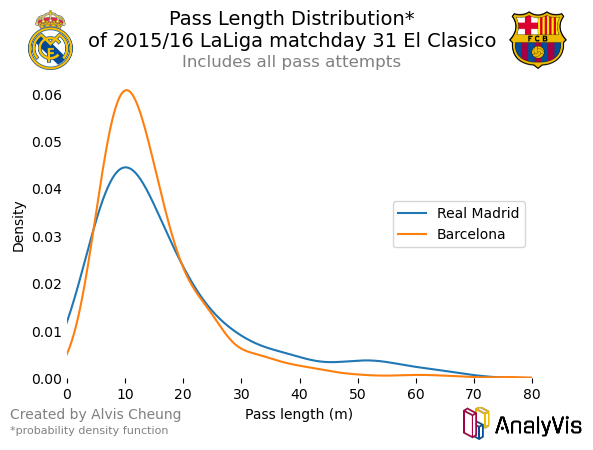LaLiga 2015/16 El Clasico - Passes
- Alvis Cheung

- Feb 26, 2024
- 3 min read
Updated: Feb 27, 2024
The 2015/16 LaLiga season held an intense race between Barcelona, Real Madrid, and Atletico Madrid. Barca successfully retained the title with only 1 and 3 points ahead of the two Madrid teams.
After Zinedine Zidane taking over as the new Los Blancos' manager mid-season, Real Madrid was on a 4-game LaLiga winning strike (which went on to 12 until the last league game) in the third El Clasico of the season. Zidane's side was craving for a win in this match after losing the first two encounters, while Enrique's side wished to widen their lead in the table.
In this first post of AnalyVis, we will analyse the passes in the El Clasico of 2015/16 LaLiga matchday 31. We will continue to dive into other aspects of the game in the coming posts. (Data Source: StatsBomb)
Pass Attempts
In the third clash of the 2015/16 season between the clubs, Barcelona was obsessed in passing and played around in the middle, while Madrid held their ball more in their own half and attacked from the flanks.
Real Madrid
Madrid's passes were spread across the field, i.e. larger coloured region in the heatmap. Many passes, especially from the defenders, were directed towards the flanks: passing within the flanks (RB, LB and RCM), and switching play (the two CBs and CDM). Meanwhile, the attackers roamed and passed the ball all around the pitch to connect plays.
With Barcelona dominating the middle, Madrid only made a handful of passes into the top of the twelve-yard box, most of them being long balls. Meanwhile, the largest portion of passes were around Toni Kroos and Marcelo on the left. [Pass Maps]
Halving Barca's pass attempts (350 < 712), Madrid played with a more direct style: more forward passes and long passes. [Pass angle and length]
Barcelona
The Blaugrana's passes were very concentrated around the centre circle, i.e. small bright region in the heatmap. They played in a more zonal approach: sticking to their position, e.g. RCM Rakitic staying in the right midfield, attackers staying in opponent's half. One significant difference between Barcelona and Real Madrid is the passing style of the two CBs: short lateral passes VS long forward passes.
The players made so many passes in the middle, such that even there were quite a number of passes towards the danger area, they were unseen on the heatmap. [Pass Maps]
Barcelona playing tika-taka football, they had over 700 pass attempts with extreme accuracy: which were more towards the sides, and of short distance. [Pass angle and length]
Passing Network
Barcelona
We can see that even though Messi and Busquets were the key passers and centroid of Barca's passing network, all other players were also heavily involved, that most of them had at least 5 passes to their neighbouring teammates.
Even though Messi was a RW on paper, he dropped deep to orchestrate attacking plays, played as a CAM with the support of the CDM (Busquets) and CMs (Iniesta & Rakitic).
On the flanks, we can see a typical Barca attacking play: the full backs connecting with the wingers (Alba-Neymar, Alves-Messi).
Real Madrid
A clear difference from Barca's network, Los Blancos played with far less passes, not many of them made more than 5 passes with their neighbouring teammates.
Even though Modric was the centroid of the network, he wasn't the direct outlet of attacks. Bale was the target man of attacks, with Carvajal and Benzema made the most passes to him, while being the furthest front on the pitch.
Also, we can see that Real Madrid's each flank played on their own: Modric, Carvajal and Bale connected well on the right, while Kroos, Marcelo, Ronaldo and Benzema connected on the left.
Comparing with Barca's defence pushing high and heavily involving in the play, Real Madrid's defence kept low and were much quieter.
Related codes can be found here on GitHub.
By Alvis Cheung | 24 Feb 2024












wow!!!!!!